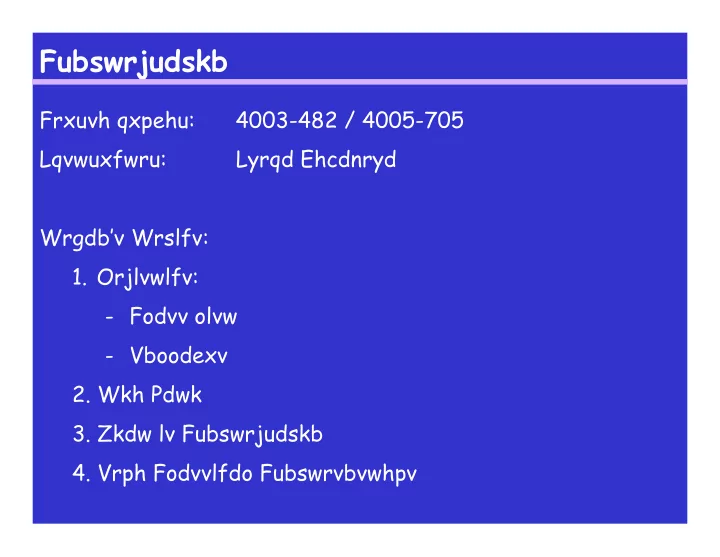

Fubswrjudskb Frxuvh qxpehu: 4003-482 / 4005-705 Lqvwuxfwru: Lyrqd Ehcdnryd Wrgdb’v Wrslfv: 1. Orjlvwlfv: - Fodvv olvw - Vboodexv 2. Wkh Pdwk 3. Zkdw lv Fubswrjudskb 4. Vrph Fodvvlfdo Fubswrvbvwhpv
Cryptography Course number: 4003-482 / 4005-705 Instructor: Ivona Bezáková Today’s topics: 1. Logistics: - Class list - Syllabus 2. The Math 3. What is Cryptography 4. Some Classical Cryptosystems
The Math We will go beyond descriptions of cryptographic algorithms and ways how to break them. We will use a lot of math and CS theory in this course, including: - some abstract algebra (number theory, groups, rings, fields) - some linear algebra - some probability and information theory - some complexity theory It is important to be comfortable with math!
What is Cryptography - the study of secure communication over insecure channels. Typical scenario: Alice Bob Eve
What is Cryptography Alice Bob Eve Private-key cryptosystems: Chapter 2 (& 4) - Alice and Bob agree on a key beforehand Alice: plaintext -> encryption (via the key) -> ciphertext -> send to Bob Bob: decrypt the ciphertext (using the key) to reconstruct the plaintext
What is Cryptography Eve: - she does not know the key, she cannot decrypt… ??? - she tries to read the current message, she can also try to figure out the key - in our book she sometimes acts as a malicious active attacker (usually called Mallory): corrupting Alice’s message, or masquerading as Alice Symmetric-key cryptosystems: - private-key cryptosystems use (essentially) the same key for encryption and decryption
Some Cryptanalysis Terminology Cryptanalysis - the process of attempting to compute the key - the most common attack models: - ciphertext only attack - known plaintext attack - chosen plaintext attack - chosen ciphertext attack What’s the weakest type of attack?
Cryptographic Applications 1. Confidentiality 2. Data integrity 3. Authentication 4. Non-repudiation
Classical Cryptosystems (Starting Chapter 2, sneaking in some math from Chapter 3.) Conventions: - plaintext : lowercase - CIPHERTEXT : uppercase - Spaces and punctuations will be usually omitted. - Letter of the alphabet will be often identifies with numbers 0,1,…,25.
Monoalphabetic Ciphers - Each letter is mapped to a unique letter. - Examples: shift cipher, substitution cipher, affine cipher - We will need modular arithmetic (and we’ll introduce more than we need in this chapter – it will all be useful later).
Modular Arithmetic Let a, b be integers, m be a positive integer. We write: a ≡ b (mod m) if m divides (a-b) (Read it as: “a is congruent to b mod m”.) Examples: (true/false) 7 ≡ 5 (mod 3) 4 ≡ 1 (mod 3) 7 ≡ 1 (mod 3) -4 ≡ -1 (mod 3) 66 ≡ 0 (mod 3) -8 ≡ 7 (mod 3)
Modular Arithmetic Let a be an integer, m be a positive integer. We use: a mod m to denote the remainder when a is divided by m. The remainder is always a number from {0,1,2,…,m-1}. Examples: 8 mod 3 = 1 mod 1 = 0 mod 2 = 63 mod 7 = -8 mod 3 = 3 mod 6 = -63 mod 7 = Is % in Java/C/C++ the same as mod ?
Modular Arithmetic Z m denotes the set {0,1,2,…,m-1}, with two operations: - addition (modulo m) - multiplication (modulo m) Z m is a commutative ring, i.e.: - addition and multiplication (mod m) are closed, commutative, associative, and multiplication is distributive over addition - 0 is the additive identity - each element has an additive inverse Note: For m>1, Z m is a commutative ring with identity.
Modular Arithmetic Z m denotes the set {0,1,2,…,m-1}, with two operations: - addition (modulo m) - multiplication (modulo m) Z m is a commutative ring, i.e.: - addition and multiplication (mod m) are closed, commutative, associative, and multiplication is distributive over addition - 0 is the additive identity - each element has an additive inverse Note: For m>1, Z m is a commutative ring with identity.
Shift Cipher The key k is an element of Z 26 . We encrypt a letter x ∈ Z 26 as follows: x → (x+k) mod 26 How to decrypt ? x → Remarks: - For k=3 this is known as the Caesar cipher, attributed to Julius Caesar. - Shift cipher works over any Z m .
Shift Cipher How good is it ? - the good: efficient encryption/decryption computation - the bad: easy to attack (not very secure) - how ? Kerckhoff’s Principle: - Eve knows the cipher but does not know the key. - Always assumed in cryptanalysis.
Substitution Cipher - Monoalphabetic cipher defined by a permutation of the alphabet. - Example: abcdefghijklmnopqrstuvwxyz ONETWHRFUISXVGABCDJKLMPQYZ What is the key in this example ? - Exercise: decode: EDYBKARDOBFY
Substitution Cipher How good is it ? - the good: efficient encryption/decryption - the bad(?): is it secure ? - approach 1: try all possible keys - is this feasible ? Hint: frequency tables, e.g., for English see Table 2.1, page 17
Affine Ciphers The key is a pair ( α , β ) ∈ Z 26 × Z 26 such that gcd( α ,26)=1. Then, encryption is done via an affine function: x → ( α x + β ) mod 26 How to decrypt ? x → Remark: The affine cipher can be defined over any Z m .
Affine Ciphers Questions: - How does it relate to the shift and the substitution ciphers ? - How many possible keys are there ? - Why do we have the condition gcd( α ,26)=1 ? - What is α -1 ?
Affine Ciphers Questions: - Efficiently computable encryption and decryption ? - Is it secure ? How to cryptanalyze ?
Recommend
More recommend